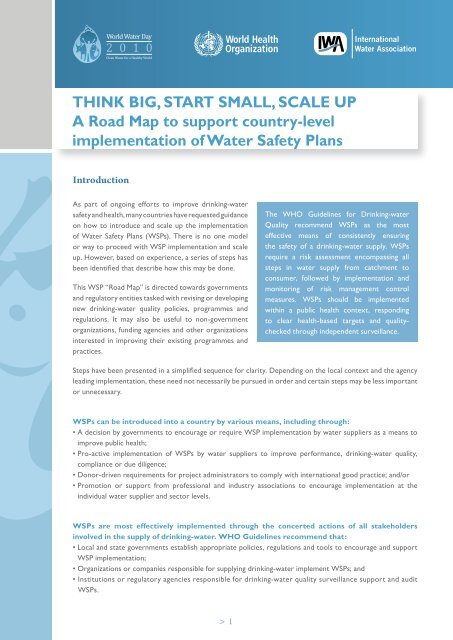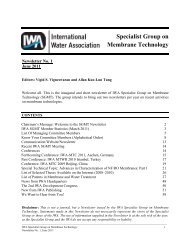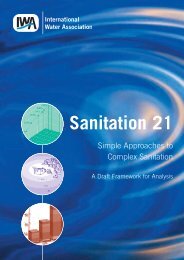THINK BIG, START SMALL, SCALE UP A Road Map to ... - IWA
THINK BIG, START SMALL, SCALE UP A Road Map to ... - IWA
THINK BIG, START SMALL, SCALE UP A Road Map to ... - IWA
- No tags were found...
You also want an ePaper? Increase the reach of your titles
YUMPU automatically turns print PDFs into web optimized ePapers that Google loves.
<strong>THINK</strong> <strong>BIG</strong>, <strong>START</strong> <strong>SMALL</strong>, <strong>SCALE</strong> <strong>UP</strong>A <strong>Road</strong> <strong>Map</strong> <strong>to</strong> support country-levelimplementation of Water Safety PlansIntroductionAs part of ongoing efforts <strong>to</strong> improve drinking-watersafety and health, many countries have requested guidanceon how <strong>to</strong> introduce and scale up the implementationof Water Safety Plans (WSPs). There is no one modelor way <strong>to</strong> proceed with WSP implementation and scaleup. However, based on experience, a series of steps hasbeen identifi ed that describe how this may be done.This WSP “<strong>Road</strong> <strong>Map</strong>” is directed <strong>to</strong>wards governmentsand regula<strong>to</strong>ry entities tasked with revising or developingnew drinking-water quality policies, programmes andregulations. It may also be useful <strong>to</strong> non-governmen<strong>to</strong>rganizations, funding agencies and other organizationsinterested in improving their existing programmes andpractices.The WHO Guidelines for Drinking-waterQuality recommend WSPs as the mosteffective means of consistently ensuringthe safety of a drinking-water supply. WSPsrequire a risk assessment encompassing allsteps in water supply from catchment <strong>to</strong>consumer, followed by implementation andmoni<strong>to</strong>ring of risk management controlmeasures. WSPs should be implementedwithin a public health context, responding<strong>to</strong> clear health-based targets and qualitycheckedthrough independent surveillance.Steps have been presented in a simplifi ed sequence for clarity. Depending on the local context and the agencyleading implementation, these need not necessarily be pursued in order and certain steps may be less importan<strong>to</strong>r unnecessary.WSPs can be introduced in<strong>to</strong> a country by various means, including through:• A decision by governments <strong>to</strong> encourage or require WSP implementation by water suppliers as a means <strong>to</strong>improve public health;• Pro-active implementation of WSPs by water suppliers <strong>to</strong> improve performance, drinking-water quality,compliance or due diligence;• Donor-driven requirements for project administra<strong>to</strong>rs <strong>to</strong> comply with international good practice; and/or• Promotion or support from professional and industry associations <strong>to</strong> encourage implementation at theindividual water supplier and sec<strong>to</strong>r levels.WSPs are most effectively implemented through the concerted actions of all stakeholdersinvolved in the supply of drinking-water. WHO Guidelines recommend that:• Local and state governments establish appropriate policies, regulations and <strong>to</strong>ols <strong>to</strong> encourage and supportWSP implementation;• Organizations or companies responsible for supplying drinking-water implement WSPs; and• Institutions or regula<strong>to</strong>ry agencies responsible for drinking-water quality surveillance support and auditWSPs.> 1
experts from other countries who have had experience in WSP implementation <strong>to</strong> better inform on steps <strong>to</strong>be taken <strong>to</strong> introduce WSPs.2. Establish preliminary WSP visionMiles<strong>to</strong>ne: Establishment of a national WSPsteering committee and an agreed country visionfor improving the management of drinking-waterquality through the use of WSPs.Outcome: Attainment of initial governmentcommitment <strong>to</strong> actively promote and pursue WSPimplementation.Establish a national steering committeeThe national steering committee’s rolesinclude promoting awareness of and advocatingfor WSP implementation, developing thenational WSP vision and overseeing andproviding guidance on its implementation.This committee should consist of seniorgovernment decision makers from thehealth and the water sec<strong>to</strong>r, including thosewith responsibility for water supply, waterquality management and the regulation andenforcement of drinking-water laws andstandards. The steering committee requiresstrong leadership, adequate resources, regularmeetings and communications among themembers and political support. If possible, itshould be a formally endorsed committee (e.g.with a terms of reference).Initiate a WSP visionBased on an evaluation of existing waterquality standards, regulations and policies, thestatus of drinking-water quality managementpractices and the perceived benefi ts of WSPs,the steering committee should coordinate thedevelopment of an initial WSP vision. This maydescribe an ultimate goal of having all watersuppliers develop and implement WSPs orit may simply be <strong>to</strong> require and encouragethe adoption of preventive risk managementapproaches.Case study: Process of introducingWSPs in the Sultanate of OmanThe fi rst WSP in Oman is currently being developedin Muscat under the leadership of the Public Authorityfor Electricity and Water (PAEW). The Ministry ofHealth (MoH) initiated the introduction of WSPs inthe country, with a request <strong>to</strong> the WHO RegionalCentre for Environmental Health Activities (CEHA)for policy advice and technical assistance in 2008. Thisresulted in the development of a fi rst national vision<strong>to</strong> require all water suppliers in Oman <strong>to</strong> have WSPsin place and the establishment of a steering committeewhich has initiated and now oversees the developmentand implementation of a WSP demonstration projectin Muscat. This steering committee is comprised ofsenior representatives of the PAEW, the MoH andthe Ministry of Regional Municipality and WaterResources.To support development of the WSP demonstrationproject, an external consultant was engaged at theend of 2008 and details of the pilot demonstrationproject were established, including the location ofthe pilot, its scope, miles<strong>to</strong>nes and time frames. InMay 2009, the consultant provided initial training onthe WSP process <strong>to</strong> the technical WSP team that iscollectively responsible for developing the WSP. Sincethen, the system description and hazard analysis havebeen fi nalized and documented. A regional meeting wasthen convened on WSPs in Amman, Jordan, at which thesteering committee shared the approach taken and theinitial lessons learned in Oman.Most recently, additional training on the next stepsof the WSP approach has been provided by theconsultant. Benefi ts have already been seen as aresult of WSP development, including improvedstakeholder relationships and a better understandingof the risks affecting the water supply. In fact, thesteering committee already plans <strong>to</strong> implement WSPsin other regions of Oman once the demonstrationproject is fi nished. To support this process and thedemonstration project, the MoH has restructured itswater and sanitation section.> 3
The national steering committee should have an oversight role in the development and implementation ofthe WSP demonstration. It is also responsible for ensuring that the WSP team has suffi cient resources forsuccessful implementation of the demonstration project.Evaluate WSP demonstration projectThe pilot should be evaluated by the WSP team and the steering committee against the following criteria <strong>to</strong>inform the national vision and strategy for scaling up:• Feasibility in national and local context under existing resources;• Immediate and expected longer-term added value for consumers, water suppliers, regula<strong>to</strong>rs and othersconcerned about water quality and health;• Resources needed (including personnel, knowledge, supporting materials and <strong>to</strong>ols, time, money andequipment);• Challenges faced during implementation and how they were addressed;• Differences between current practices and those required for WSP implementation in operation andmanagement; and• Other lessons learned.4. Establish national strategy <strong>to</strong> scale up WSP implementationMiles<strong>to</strong>ne: Convening of a multi-stakeholder consultation process <strong>to</strong> review and refi ne the original vision and developa detailed strategy for wide-scale WSP implementation.Outcome: National strategy for scaling up WSP implementation developed and agreed <strong>to</strong> by key stakeholders.Develop the national strategy for WSP scale upBased on experience gained from the demonstration project, the steering committee should re-evaluate theinitial WSP vision and develop a detailed strategy <strong>to</strong> achieve the vision. This will require suffi cient governmentsupport for WSP scale up and the confi rmation of resources (including mobilization of external funding, ifrequired) for the steering committee <strong>to</strong> carry out this work. Key points <strong>to</strong> consider, or include in the strategyare the following:• A review of existing water quality standards, regulations and policies <strong>to</strong> evaluate the strengths andweaknesses of existing frameworks <strong>to</strong> see how the WSP approach can complement and improve them. Thisevaluation may have been initiated when the initial WSP vision was established and the information gatheredat that time should be utilized. While many countries’ regulations require moni<strong>to</strong>ring of the drinkingwatersupplied <strong>to</strong> consumers against water quality standards, the comprehensive risk assessment and riskmanagement approach implicit in WSPs <strong>to</strong> most effectively protect public health is often lacking.• A review of roles, responsibilities and capabilities of relevant institutions, including the effectiveness ofcurrent working structures. Furthermore, the institutional roles and responsibilities that are needed forsuccessful and sustainable adoption of the WSP approach will need <strong>to</strong> be identifi ed. Further details of thelatter activity is described in section 6.• A description of WSP policy and regula<strong>to</strong>ry objectives and rationale for them. The steering committeeshould understand the implications of the policy and regula<strong>to</strong>ry objectives that are being considered. For> 5
7. Implement WSPs and verify their effectivenessMiles<strong>to</strong>ne: Water suppliers are implementing WSPs which are regularly subjected <strong>to</strong> audits and compliancemoni<strong>to</strong>ring.Outcome: Risk management practices are implemented with confi rmation that WSPs are appropriately developed.Continue implementing WSPsWater suppliers will need guidance and support from time <strong>to</strong> time as they develop, implement and periodicallyreview their WSPs. Therefore, the capacity building activities such as training and if possible, utility-utilitypartnerships, should run in parallel with WSP implementation. Specifi c mechanisms <strong>to</strong> provide ongoingsupport could also be established <strong>to</strong> facilitate implementation. For example, resource centres or WSPadvisory services could be established. The regula<strong>to</strong>r, public health inspec<strong>to</strong>r and other WSP experts shouldalso be readily available sources of information.Verify that the WSPs are appropriateThe WSPs should be independently verifi ed by the surveillance agency (regula<strong>to</strong>r) or another body that isappointed by the surveillance agency <strong>to</strong> ensure that the WSP is working properly. These audi<strong>to</strong>rs will need<strong>to</strong> be appropriately trained and qualifi cation requirements should be established. An auditing plan should bedeveloped that includes the time and frequency of the audits, scope of the audit and assessment and reportingcriteria. Processes, specifying corrective actions <strong>to</strong> be taken, should also be in place for when the WSPsare not found adequate, including timeframes for rectifying the identifi ed issues, and potentially, sanctions.Wherever possible generally and certainly in the early stages of WSP implementation, audits should be treatedas learning and improving opportunities rather than occasions for imposing penalties.WSP development in a small water supply system, Bhutan© Payden
8. Review overall WSP experiences and share lessons learnedMiles<strong>to</strong>ne: Progress report on country wide WSP implementation citing improvements, challenges and drinkingwaterquality outcomes.Outcome: Long-term and sustained improvements in the management of drinking-water supplies and in drinkingwaterquality.Continuously review WSP implementationWSPs are meant <strong>to</strong> be an ongoing process of water supply management and improvement and not a documentthat is completed one time and then placed on a shelf. Accordingly, progress in WSP implementation is iterativeand should be continuously reviewed. At a national level, this should include, for example, identifi cation ofimprovements in terms of public health, compliance with drinking-water quality standards and overall duediligence of water suppliers. Gaps in implementation – related <strong>to</strong> new risks and research, capacity andfi nancial needs should also be identifi ed and addressed.Share knowledge and experiencesTo facilitate in-country progress in WSP implementation, it is important <strong>to</strong> frequently share the lessonslearned among stakeholder groups. Gained improvements could also be communicated <strong>to</strong> the public. To aidglobal progress, it is also important <strong>to</strong> inform the regional and international community about in-countryexperiences; sharing with WHO and <strong>IWA</strong> through WSPortal, publication of papers, attendance of conferencesand more formal bi-lateral partnerships between countries can help facilitate this.AcknowledgementsA WHO/EMRO meeting on drinking-water quality management convened in Amman Jordan, 26-29 Oc<strong>to</strong>ber 2009 and hosted by the Centre forEnvironmental Health Activities, confi rmed the need, and provided the impetus for the development of this document. Hamed Bakir (WHO/EMRO)strongly encouraged its further development. The authors are Jennifer De France and Bruce Gordon (WHO-HQ), Oliver Schmoll (Federal EnvironmentAgency, Germany) and Tom Williams (<strong>IWA</strong>). Advice and important inputs were provided by Hamed Al-Hasni (Public Authority for Electricity andWater, Oman), Salim Al-Wahaibi (Ministry of Health, Oman), Robert Bos, Jennifer Mercer and Sinead Tuite (WHO-HQ), David Drury, Pranav S. Joshi(National Environment Agency, Singapore), Tasleem Hasan (Pacifi c Islands Applied Geoscience Commission), Nii Okai Kotei (Public Utilities Regula<strong>to</strong>ryCommission, Ghana) and Colin McLaren (Drinking Water Quality Regula<strong>to</strong>r, Scotland).WHO is grateful <strong>to</strong> the Ministry of Health, Labour and Welfare, Japan; the Australian Agency for International Development; the Government of theUnited States of America; Ministry of Environment and Water Resources, Singapore; Health Canada; and the Drinking Water Inspec<strong>to</strong>rate, UnitedKingdom, for their support <strong>to</strong> WHO’s work on drinking-water safety.© World Health Organization 2010All rights reserved. Publications of the World Health Organization can be obtained from WHO Press, World Health Organization, 20 Avenue Appia,1211 Geneva 27, Switzerland (tel.: +41 22 791 3264; fax: +41 22 791 4857; e-mail: bookorders@who.int). Requests for permission <strong>to</strong> reproduce ortranslate WHO publications – whether for sale or for noncommercial distribution – should be addressed <strong>to</strong> WHO Press, at the above address (fax: +4122 791 4806; e-mail: permissions@who.int).The mention of specifi c companies or of certain manufacturers’ products does not imply that they are endorsed or recommended by the World HealthOrganization in preference <strong>to</strong> others of a similar nature that are not mentioned. Errors and omissions excepted, the names of proprietary products aredistinguished by initial capital letters.All reasonable precautions have been taken by the World Health Organization <strong>to</strong> verify the information contained in this publication. However, thepublished material is being distributed without warranty of any kind, either expressed or implied. The responsibility for the interpretation and use of thematerial lies with the reader. In no event shall the World Health Organization be liable for damages arising from its use.The named authors alone are responsible for the views expressed in this publication.The International Water Association (<strong>IWA</strong>), a global network of water professionals, is a Non-Government Organization (NGO) in Offi cial Relationswith WHO. <strong>IWA</strong> promotes WSPs with WHO through a formal project collaboration agreement and associated programme of work lasting through2015 and through its membership of water utilities, research institutes, industry, and individual professionals. <strong>IWA</strong> is a company registered in EnglandNo.3597005. Registered Charity (England) No.076690.> 10
















